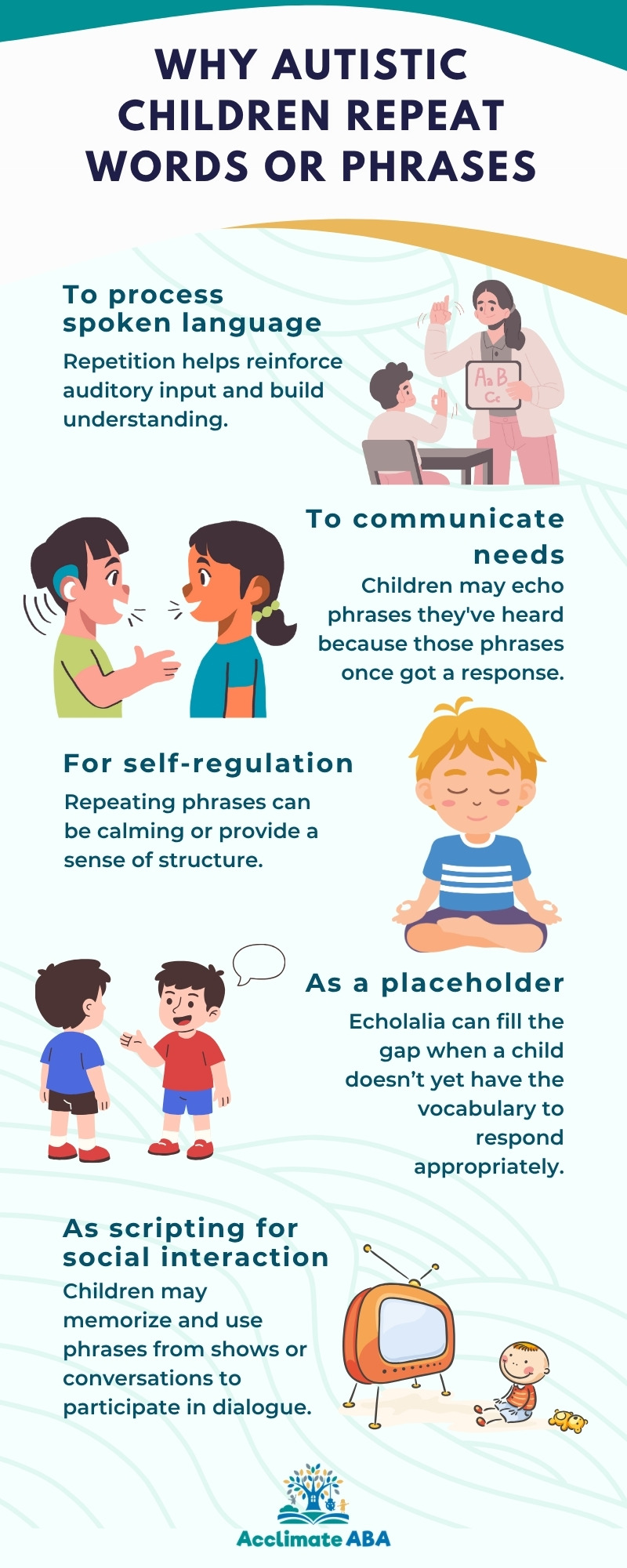Key Points:
- Echolalia, or repeating words and phrases, is a common form of communication in autism, often misunderstood by caregivers.
- Repetition serves multiple functions, such as processing language, expressing needs, or self-soothing.
- ABA therapy provides structured interventions to help children move from echolalia to more functional communication.
Understanding why a child with autism keeps repeating words can be confusing and even frustrating for parents. Yet, repetition—whether of single words, full phrases, or sounds—is often a meaningful part of how autistic individuals process the world. According to research, up to 80% of autistic individuals exhibit behaviors that involve repeating words or phrases.
This phenomenon, called echolalia, is more than just mimicry. It can serve a variety of functions, from communication to emotional regulation. In this article, we’ll go over what echolalia really means, why it happens, and what families can do to support language development.
What is Echolalia and How Does It Relate to Autism?
Echolalia is the repetition of words or phrases and is a common feature in autism, often used to process language, communicate, or self-regulate.
In children with autism, repeating words isn’t necessarily random or meaningless. Echolalia may appear during early language development or persist into later childhood, depending on the individual. It can take several forms, each with different purposes, and may actually represent a step forward in learning language and making sense of social interactions.
Why Do Autistic Children Repeat Words or Phrases?
Children on the autism spectrum may repeat words or phrases for a variety of reasons. While some repetition may seem out of place or disconnected, there is often an underlying function behind it. Understanding the reason behind the repetition helps parents respond in a more supportive way.
These are the most common reasons why autistic individuals repeat language:
 Recognizing these motives turns a seemingly odd behavior into a clue about what the child is trying to do or say.
Recognizing these motives turns a seemingly odd behavior into a clue about what the child is trying to do or say.
What are the Different Types of Echolalia?
Echolalia isn’t one-size-fits-all. It appears in different forms depending on timing, function, and language skills. Understanding the distinctions can help tailor intervention and support strategies.
There are two primary types of echolalia:
Immediate Echolalia
The child repeats words or phrases right after listening to them, often to process speech or maintain conversation flow. It may appear in everyday dialogue or during moments of excitement or stress.
Delayed Echolalia
Phrases are repeated after a delay—minutes, hours, or days later. These repetitions often come from prior conversations, TV shows, or media, serving as communication attempts or expressions of emotion.
Recognizing both type and function helps families and therapists decide how best to respond or intervene.
How Does Echolalia Evolve Over Time?
Echolalia is not always permanent. For many children, it represents a stepping stone in language development. Some will move beyond echolalia as their communication becomes more functional. Others may continue to use it in specific situations well into adulthood.
Progression typically follows these stages:
- Stage 1: Repetition without apparent understanding
- Stage 2: Repetition with increased contextual awareness
- Stage 3: Partial repetition with inserted functional words
- Stage 4: Functional responses with reduced reliance on echoing
The timeline varies widely. However, many children who receive targeted support through therapy, especially ABA, can shift from echoing to spontaneous language use.
When Should Parents Be Concerned About Echolalia?
Not all repetition is a cause for concern. In early language development, even in neurotypical children, some level of repetition is expected. What matters more is the function, frequency, and whether the behavior evolves over time.
Consider seeking professional guidance if:
1. Persistent Echolalia Beyond Age 3–4
If repeated phrases continue to dominate speech past age 3–4, it may indicate a delay in developing more flexible and functional language skills that require professional evaluation.
2. Limited Spontaneous Language
When a child rarely uses original or meaningful speech and relies heavily on repetition, it may suggest difficulty with expressive language and warrant support from a speech-language pathologist.
3. Interference with Learning or Socializing
If echolalia disrupts classroom learning, play, or conversations with others, it could signal that the repetition is becoming a barrier rather than a communication bridge.
4. Increasing Rigidity or Disruption
When repeated speech becomes more frequent, intense, or interferes with daily activities, it may reflect growing distress or inflexibility, indicating the need for targeted intervention.
Evaluation by a speech-language pathologist or behavior analyst can help identify whether the echolalia is functional or a barrier to development.
How Can Parents Support a Child Who Uses Echolalia?
Responding supportively to echolalia means understanding its purpose and offering models that encourage growth. Rather than discouraging the repetition, use it as a bridge toward more meaningful language.
Here are ways parents can help:
1. Model Functional Language
Use short, context-appropriate phrases your child can echo meaningfully. Repetition of useful language helps build a foundation for more independent and spontaneous communication over time.
2. Use Visual Supports
Incorporate visuals like picture schedules or communication boards to reduce verbal pressure and guide understanding, which can help children rely less on repeated speech for communication.
3. Pause and Prompt New Responses
After your child echoes a phrase, pause briefly and gently suggest an alternative. This encourages flexible thinking and helps build varied, functional language use.
4. Expand on Echoed Phrases
Add to your child’s repeated words by modeling a fuller, more natural sentence. This helps teach grammar, tone, and conversational flow in real-life contexts.
5. Be Patient and Encouraging
Support your child without criticism. Consistent positive reinforcement and understanding during echolalic moments foster a safe space for language development and self-expression.
Engaging with your child during echolalic moments instead of ignoring or correcting them builds trust and language confidence.
What Therapies Are Helpful for Reducing Echolalia?
While echolalia may decrease over time naturally, therapeutic intervention can accelerate the development of functional communication. One of the most evidence-based approaches is Applied Behavior Analysis (ABA).
ABA focuses on understanding the purpose behind behavior and teaching alternatives that serve the same function. For echolalia, that might include:
- Functional Communication Training (FCT)
- Natural Environment Teaching (NET)
- Discrete Trial Training (DTT)
- Language expansion and prompting strategies
- Echoic to mand transfer
Therapists work to reduce non-functional repetition while reinforcing more appropriate, individualized language skills. The approach is tailored to the child’s current level of communication and cognitive development.
Is Echolalia Always a Bad Thing?
Not at all. Echolalia is often misunderstood as “meaningless.” In reality, it can be an early step toward language acquisition. Some children may never speak without going through a phase of repetition. Others use echolalia as a tool for self-regulation or comfort, especially in stressful environments.
Instead of viewing echolalia as a problem, it helps to think of it as a clue. It tells you what kind of language the child is exposed to, what excites them, and how they try to interact with others. By recognizing echolalia as communication, families and therapists can shift their approach from stopping it to shaping it into something more purposeful.
Create Steady Progress With ABA Therapy
When echolalia starts to affect social development, learning, or day-to-day communication, it may be time to seek structured help. At Acclimate ABA, we offer personalized ABA therapy in Utah designed to help children with autism develop more functional, independent communication skills.
Get in touch with us today to learn how we can help your child move from repeating to expressing. Together, we can help your child find their voice.

